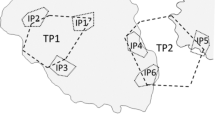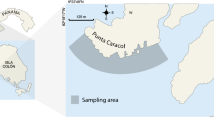Summary
Factors governing the size of territories defended by the pomacentrid reef fish, Parma victoriae, were investigated, prompted by contradictory predictions in the literature concerning the effects of food supply and competitors. Observations were carried out over the non-breeding period (March–October) on a medium density population in which territories were partially contiguous. The territory size of adult fish varied between 3 and 26 m2, and was inversely correlated with local densities of conspecifics. The same range in territory size was found for both males and females, which did not differ in the time they spent on territory defence and foraging activities. No correlation existed between territory size and the abundance of algal food, body size, age or time spent on territory defence. Also, there was little variation in territory size over time, despite seasonal changes in the abundance of food algae.
Experimental reduction of food supplies on isolated territories of males and females had no effect on territory size. In a higher density habitat an experiment was carried out in which population density and food abundance were simultaneously manipulated. This showed that territory size was primarily determined by intraspecific interactions, as territories exhibited considerable increases in size upon removal of neighbours. No changes in the size of defended areas resulted from either artificial increases or decreases of food levels. There were also no changes in the time spent on defence of territories, foraging time or feeding rates associated with food manipulations or territory expansion, which suggested that food was not a limited resource. This conflicted with current theories proposed to explain territory defence and expansion. It is hypothesized that intraspecific interactions constrain territory size well below the optimum in terms of the abundance of preferred food algal species.
Similar content being viewed by others
References
Armstrong JT (1965) Breeding home range in the nighthawk and other birds; its evolutionary and ecological significance. Ecology 46:619–629
Assem J van den (1967) Territory in the three-spined stickleback Gasterosteus aculeatus L. An experimental study in intraspecific competition. Behav Suppl 16:1–164
Baker MC, Mewaldt LR (1979) The use of space by white-crowned sparrows: Juvenile and adult ranging patterns and home range versus body size comparisons in an avian granivore community. Behav Ecol Sociobiol 6:45–52
Black R (1971) Hatching success in the three-spined stickleback (Gasterosteus aculeatus) in relation to changes in behavior during the parental phase. Anim Behav 19:532–541
Brown JL (1975) The evolution of behavior. Norton, New York
Burger J (1981) Super-territories: A comment. Am Nat 118:578–580
Colgan P (1979) Is a super-territory strategy stable? Am Nat 114:604–605
Davies NB (1978) Ecological questions about territorial behaviour. In: Krebs JR, and Davies NB (eds), Behavioural ecology: an evolutionary approach, Blackwell, Oxford, pp 317–350
Dhondt AA, Hublé J (1968) Age and territory in the great tit (Parus m. major L.). Angewandte Ornithologie 3:20–24
Dill LM (1978) An energy-based model of optimal feeding-territory size. Theor Pop Biol 14:396–429
Dill LM, Ydenberg RG, Fraser AHG (1981) Food abundance and territory size in juvenile coho salmon (Oncorhynchus kisutch). Can J Zool 59:1801–1809
Dixon KL (1956) Territoriality and survival in the plain titmouse. Condor 58:169–182
Ebersole JP (1980) Food density and territory size: An alternative model and a test on the reef fish (Eupomacentrus leucostictus). Am Nat 115:492–509
Ewald PW, Carpenter FL (1978) Territorial responses to energy manipulations in the Anna hummingbird. Oecologia (Berlin) 31:277–292
Ewald PW, Hunt GL, Warner M (1980) Territory size in Western gulls: Importance of intrusion pressure, defence invements and vegetation structure. Ecology 61:80–87
Franzblau MA, Collins JP (1980) Test of a hypothesis of territory regulation in an insectivorous bird by experimentally increasing prey abundance. Oecologia (Berlin) 46:164–170
Getty T (1979) On the benefits of aggression: The adaptiveness of inhibition and super-territories. Am Nat 114:605–609
Harris RN (1979) Aggression, super-territories and reproductive success in tree swallows. Can J Zool 55:2072–2078
Hixon MA (1980) Food production and competitor density as the determinants of feeding territory size. Am Nat 115:510–530
Hixon MA (1981) An experimental analysis of territoriality in the California reef fish Embiotoca jacksoni (Embiotocidae). Copeia 1981:653–665
Hixon MA (1982) Energy maximisers and time minimers: theory and reality. Am Nat 119:596–599
Jones GP (1981) Spawning-site choice by female Pseudolabrus celidotus (Pisces: Labridae) and its influence on the mating system. Behav Ecol Sociobiol 8:129–142
Jones GP (1983) The influence of habitat and behavioural interactions on the local distribution of the wrasse, Pseudolabrus celidotus. Env Biol Fish 9:in press
Kodric-Brown A, Brown JH (1978) Influence of economics, interspecific competition, and sexual dimorphism on territoriality of migrant rufous humming birds. Ecology 59:285–296
Krebs JR (1971) Territory and breeding density in the great tit, Parus major. Ecology 52:2–22
Larson RJ (1980) Territorial behavior of the black and yellow rockfish and gopher rockfish (Scorpaenidae, Sebastes). Mar Biol 58:111–122
Leum LL, Choat JH (1980) Density and distribution patterns of the temperate marine fish Cheilodactylus spectabilis (Cheilodactylidae) in a reef environment. Mar Biol 57:327–337
Lockie JD (1966) Territory in small carnivores. Symp Zool Soc Lond 18:143–165
MacLean SF Jr, Seastedt TR (1979) Avian territoriality: sufficient resources of interference competition. Am Nat 114:308–312
Mares MA, Lacher TE, Willig MR, Bitar NA, Adams R, Klinger A, Tazik D (1982) An experimental analysis of social spacing in Tamias striatus. Ecology 63:267–273
Myers JP, Connors PG, Pitelka FA (1979) Territory size in winterling sanderlings: The effects of prey abundance and intruder density. The Auk 96:551–561
Myers JP, Conners PG, Pitelka FA (1981) Optimal territory size and the sanderling: Compromises in a variable environment. In: Kamil AC and Sargent TD (eds), Foraging Behavior. Ecological, ethological and psychological approaches, Garland, New York, pp 135–158
Nursall JR (1977) Territoriality in redlip blennies (Ophioblennius atlanticus — Pisces: Blenniidae). J Zool 182:205–223
Odum EP, Kuenzler EJ (1955) Measurement of territory and home range size in birds. The Auk 72:128–137
Peeke HVS, Herz MJ, Gallagher JE (1971) Changes in aggressive interaction in adjacently territorial convict cichlids (Cichlasoma nigrofasciatum): a study of habituation. Anim Behav 40:43–54
Pleasants JM, Pleasants BY (1979) The super-territory hypothesis: a critique, or why there are so few bullies. Am Nat 114:609–614
Ralph CJ, Pearson CA (1971) Correlation of age, size of territory, plumage and breeding success in white-crowned sparrows. Condor 73:77–80
Root RB (1969) The behavior and reproductive success of blue-grey gnatcatcher. Condor 71:16–31
Ross RM (1978) Territorial behavior and ecology of the anemone fish Amphiprion melanopus on Guam. Z Tierpsychol 46:71–83
Sale PF (1975) Patterns of use of space in a guild of territorial reef fishes. Mar Biol 29:89–97
Schoener TW (1971) Theory of feeding strategies. Ann Rev Ecol Syst 2:369–404
Schoener TW (1983) Simple models of optimal feeding-territory size: a reconciliation. Am Nat 121:608–629
Schoener TW, Schoener A (1980) Densities, sex ratio and population structure in four species of Bahamian Anolis lizards. J Anim Ecol 49:19–53
Schoener TW, Schoener A (1982) Intraspecific variation in home range size in some Anolis lizards. Ecology 63:809–823
Simon CA (1975) The influence of food abundance on territory size in the iguanid lizard Sceloporus jarrovi. Ecology 56:993–998
Slaney PA, Northcote TG (1974) Effects of prey abundance on density and territorial behavior of young rainbow trout (Salmo gairdneri) in laboratory stream channels. J Fish Res Board Can 31:1201–1209
Stimson J (1973) The role of the territory in the ecology of the intertidal limpet Lottia gigantea (Gray). Ecology 54:1020–1030
Taitt MJ (1981) The effect of extra food on small rodent populations: I. Deermice (Peromyscus maniculatus). J Anim Ecol 50:111–124
Taitt MJ, Krebs CJ (1981) The effect of extra food on small rodent populations: II. Voles (Microtus townsendii). J Anim 50:125–137
Tullock G (1979) On the adaptive significance of territoriality: comment. Am Nat 113:772–775
Verner J (1977) On the adaptive significance of territoriality. Am Nat 111:769–775
Watson A, Miller GR (1971) Territority size and aggression in a fluctuating red grouse population. J Anim Ecol 40:367–383
Welsh DA (1975) Savannah sparrow breeding and territoriality on a Nova Scotia dune beach. Auk 92:235–251
Wittenberger JF (1981) Animal social behavior. Duxbury, Boston
Author information
Authors and Affiliations
Rights and permissions
About this article
Cite this article
Norman, M.D., Jones, G.P. Determinants of territory size in the pomacentrid reef fish, Parma victoriae . Oecologia 61, 60–69 (1984). https://doi.org/10.1007/BF00379090
Received:
Issue Date:
DOI: https://doi.org/10.1007/BF00379090




